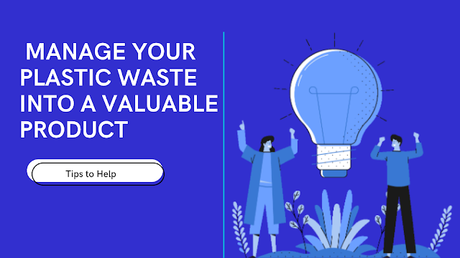Plastics themselves aren't a problem; it's their management that has proved difficult. Land-based activities harm the environment, especially marine life. Every day, India's urban areas produce about 26,000 tons of plastic. Plastic waste accounts for 6.92 percent of urban solid waste, according to the Central Pollution Control Board.
The Plastic Waste Management Rules of 2016 state that urban local bodies (ULBs) should prohibit the use of less than 50 micron thick plastic bags and that recycled plastics should not be used to package food, drinks, or any other eatables. Local governments must also have a separate collection, storage, and recycling of the plastic waste in their jurisdictions, according to the rules.

What can we make from Plastic?
1. Recycling is one thing that we can all do to help protect and improve the environment. A plastic bottle today could hold juice, water, or soda... But, after you've used it, what will it become?
Let's look at some common plastics and what they can become.
Plastic Milk Jugs and Other Containers, Milk, shampoo, laundry detergent, and household cleaner’s bottles and containers are lightweight and tough, but they're usually made of a different type of plastic than beverage bottles.
What are the possibilities for them? They can be recycled into new bottles and containers, plastic lumber, picnic tables, lawn furniture, and playground equipment, among other things.
2. Packs and wraps made of plastic we take our groceries home in plastic bags. They ensure the freshness of our bread and other foods. They even let us take goldfish from the pet store home with us. Thousands of supermarket and discount stores, like most Target, Walmart, Lowes, Safeway, and others, now embrace these bags for recycling. Also, many of the plastic wraps that cover the products we purchase (including bubble wrap!) can be recycled at many of these sites.
What are the options for them? Plastic bags and wraps can be recycled to produce plastic lumber, which is used to make park benches, garden decks and fences, and even playground equipment.
3. Bottles, Soft drinks, juice, and water bottles are a convenient way to quench thirst...
What are the options for them? T-shirts, sweaters, fleece coats, insulation for jackets and sleeping bags, carpeting, and more bottles can all be made from recycled plastic bottles.
To make enough plastic fiber to make a cool new t-shirt, it takes about ten bottles.
A sweater is made up of 63 bottles.
It only takes 14 bottles to make enough fiberfill (insulation) for a ski jacket. And 114 bottles to fill a sleeping bag with adequate insulation (fiberfill). In the United States, nearly 29.3% of plastic bottles are recycled. We can do much better if everyone joins in.
4. Caps for bottles, Plastic caps on bottles keep the soda fizzy while also keeping bugs and debris out. Even though the caps are made of a different form of plastic than the bottles, you can replace them before tossing them in the recycling bin.
What are the options for them? Bottle caps may be recycled into car batteries, garden rakes, storage bins, and reusable bags, shopping bags, yarn, ropes, brooms, and more bottle caps.
5. Packaging made of foam More than 95% of the air in plastic foam packaging is air! It covers and cushions your television and video game console as they fly from the factory to the store to your house.
What is it capable of becoming? Innovative recycling projects may transform foam packaging into plastic items like insulation, photo frames, and home building materials as well as some packaging made of foam.
Therefore if we adopted all these recycling techniques then it will be very easy to make our environment clean, and we can also come up with a new solution for plastic recycling.

